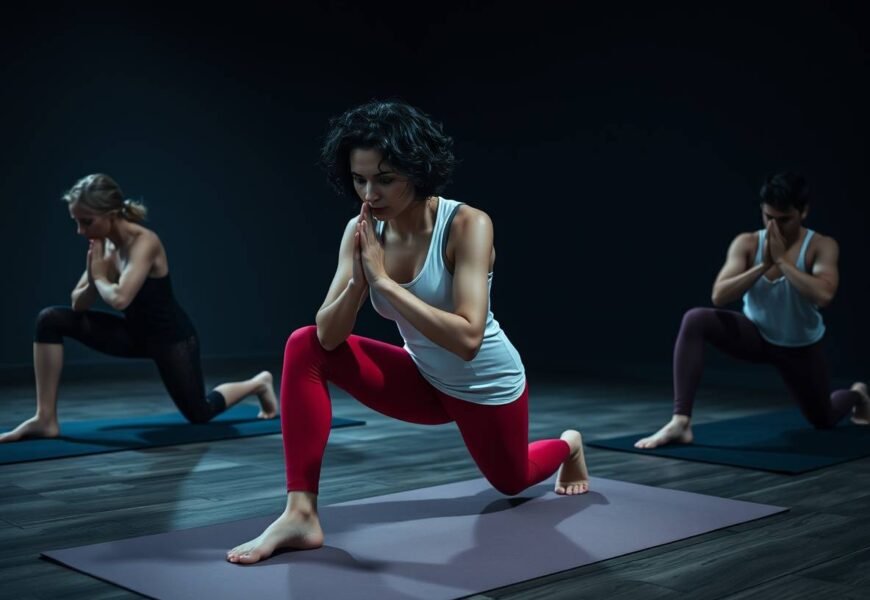Stress impacts 77% of people regularly, according to the American Psychological Association. If you’re feeling overwhelmed by daily pressures, Vinyasa flow tips can guide you toward calm and clarity. Imagine stepping away from a chaotic day, letting tension melt away as you move and breathe with purpose. This dynamic yoga practice, known for linking movement with breath, offers a pathway to inner peace, even for those just starting out.
Vinyasa yoga stands out for its fluid transitions between poses, creating a rhythm that soothes the mind and energizes the body. For beginners, though, the practice can feel intimidating. How do you begin? What if you’re not flexible enough? These are common questions, and this article is here to help. With seven practical Vinyasa flow tips, you’ll gain the confidence to start your journey and discover tranquility one pose at a time.
Why Vinyasa Flow Feels Challenging at First
Before diving into the tips, it’s worth understanding the hurdles many newcomers face. Recognizing these can make your experience smoother and more rewarding:
- Unfamiliar Terms: Words like “chaturanga” or “upward-facing dog” might sound confusing at first, leaving you unsure of what to do.
- Physical Doubts: It’s natural to wonder if your body is up to the task, especially when you see seasoned yogis moving with ease.
- Too Many Choices: With so many yoga styles out there, picking the right one can feel like a puzzle.
Here’s some encouragement: studies show yoga can cut anxiety by up to 60% and boost flexibility in just 12 weeks, per the Journal of Clinical Psychology. These benefits are within reach, no matter where you start. Let’s explore how to make Vinyasa flow work for you.
7 Vinyasa Flow Tips to Begin Your Practice
1. Master the Fundamentals
Every Vinyasa sequence builds on a handful of core poses. Getting comfortable with these basics sets a strong foundation:
- Downward Facing Dog (Adho Mukha Svanasana): A resting pose that stretches your back and legs.
- Cobra Pose (Bhujangasana): Opens your chest and strengthens your spine.
- Warrior I (Virabhadrasana I): Builds strength and focus in your lower body.
- Child’s Pose (Balasana): A gentle rest to reset and relax.
Take your time with these. Online videos, like those from Yoga with Adriene, can show you proper form and pacing.
2. Focus on Your Breath
Breath is the heart of Vinyasa. Each move pairs with an inhale or exhale, creating a flowing rhythm. Try this:
- Inhale as you lift your arms or expand your chest.
- Exhale as you fold forward or release a pose.
This connection keeps you present, easing stress while enhancing your practice’s calming effects.
3. Respect Your Body’s Signals
Your energy and flexibility will vary day to day, and that’s normal. Pushing too hard can lead to frustration or injury. Instead:
- Use props like blocks to support poses.
- Drop into Child’s Pose for a break whenever you need it.
Yoga is about growth over time, not instant mastery.
4. Set Up a Calming Space
Where you practice matters. A dedicated spot at home can deepen your focus. Consider:
- Soft lighting, like a lamp or candles, to create a peaceful vibe.
- Calming scents, such as lavender oil, to relax your senses.
- Personal touches, like a favorite blanket or small plant, to make it yours.
This space becomes your sanctuary, inviting you back to your mat.
5. Build a Steady Routine
Consistency trumps duration when starting out. Short, regular sessions help you progress without feeling overwhelmed. Here’s a sample week:
- Monday: 20-minute gentle flow.
- Wednesday: 30 minutes targeting flexibility.
- Friday: 15-minute wind-down.
- Sunday: 45-minute full practice.
Adjust this to fit your life. Over weeks, you’ll feel stronger and more centered.
6. Connect with Others
Practicing alongside others can lift your spirits and keep you motivated. Explore these options:
- Join a beginner class at a nearby studio for in-person guidance.
- Engage with yoga communities online, like Instagram groups, to share tips and encouragement.
Support from fellow beginners can make the journey feel less solitary.
7. Embrace Patience
Vinyasa isn’t about nailing every pose right away. It’s a process of discovery. Celebrate small wins, like holding a pose a bit longer or feeling more relaxed afterward. Let the practice unfold naturally.
Stories of Transformation
Seeing how others have benefited can inspire your own path. Here are two examples:
Jenna’s Calm Amid Chaos: A busy professional, Jenna felt drained by endless work demands. She started with 20-minute Vinyasa sessions twice a week after finding a simple routine online. Within a month, she noticed sharper focus and less tension. Now, her mat time is a cherished ritual that balances her hectic life.
Tom’s Anxiety Relief: Tom battled anxiety for years before a friend suggested yoga. He began at home, turning a corner into a cozy nook with a mat and soft lighting. After joining a local class, the group energy kept him going. Today, Vinyasa is his anchor, helping him stay grounded during tough moments.
These experiences show that Vinyasa adapts to your needs, offering rewards unique to your journey.
Navigating Common Obstacles
Challenges will pop up, but they’re manageable with the right approach. Here’s how to handle a few:
Fear of Being Watched: Nervous about practicing in public? Start at home or try an online class to build confidence before stepping into a studio.
Feeling Stuck: If progress slows, set a new goal, like trying a tougher pose, or mix in a workshop to spark fresh interest.
Stiffness or Fatigue: Physical limits can frustrate. Add light stretches daily to gradually improve mobility, keeping your practice gentle and steady.
Your Path to Peace Begins Now
With these seven Vinyasa flow tips, you’re equipped to start a practice that nurtures both body and mind. This isn’t just about stretching; it’s about creating space for calm and strength in your life. Step onto your mat with intention, breathe deeply, and trust that each flow brings you closer to serenity.
What will you focus on this week? Maybe it’s breathing with purpose or carving out a quiet corner for your practice. Whatever you choose, you’re investing in yourself. Begin today, and let Vinyasa guide you to a more peaceful you.














